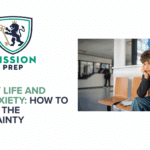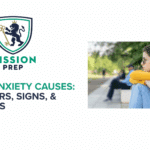High-Functioning Anxiety in Teens: Signs & How to Cope


Some teens seem to have it all together with straight A’s, packed calendars, and glowing teacher reports. But behind the calm surface, some may be battling an issue you can’t always see: high-functioning anxiety.
High functioning anxiety in teens is tricky because it can hide inside achievement. Plus, research has found that teens who strive for perfection often show signs of anxiety, but because they keep performing, they don’t always get help.¹
Research shows that many teens with anxiety and depression struggle to recover on their own – highlighting the importance of treatment options.²
The signs of high functioning anxiety aren’t always obvious. They can look like overthinking, burnout, or a fear of disappointing others. Or they may not show up at all. Also, as many teens with high-functioning anxiety tend to cope quietly, they’re often praised, which leads to an increased drive to perform.
If you’re concerned about anxiety in yourself or a loved one, professional support and advice are available. This guide can also help, as it explores the following aspects of high-functioning anxiety:
- What high-functioning anxiety in teens is
- Signs and symptoms of high-functioning anxiety
- The hidden costs of teen perfectionism
- High-functioning anxiety vs. depression in teens
- Coping tools and support for high-performing teens
What Is High-Functioning Anxiety in Teens?
High functioning anxiety in teens doesn’t always look like worry. In fact, it often looks like productivity. Students who turn in every assignment early and join every club can still feel like they’re falling behind. They may not speak up about their distress, but internally, they’re overwhelmed.
Research shows us that childhood and adolescence are developmental phases at particular risk for developing anxiety symptoms and syndromes. Symptoms can range from mild anxiety to full-blown anxiety disorders.³
Unlike teens who show obvious signs of panic or avoidance, high-functioning teens tend to internalize their anxiety. They may stay busy to stay in control. They might also over-prepare, overthink, and rarely ask for help. Their anxiety hides in plain sight, which makes it easy to miss.
This version of anxiety often overlaps with perfectionism and people-pleasing. As the evidence suggests that anxiety is a future-oriented emotion, it shows up because the future is uncertain.⁴ So, in essence, teens with high-functioning anxiety not only worry about failing, but also about not being “enough.” Over time, this quiet pressure can lead to burnout, sleep issues, or depression.
To better understand where issues begin, it helps to explore the common triggers and signs of teen anxiety, including how stress can take different forms in high-achieving youth.
Recognizing the Signs of High-Functioning Anxiety
Research shows that high-functioning anxiety in teens can develop through several contributing factors like:⁵
- Academic pressures
- Social media influence
- Family dynamics
- Societal stressors
The signs of high functioning anxiety can slip under the radar because they often show up as socially acceptable behaviors. A teen may seem organized, driven, or helpful. But behind the routine is a nervous system running on overdrive.
These subtle anxiety symptoms in youth don’t always look like panic attacks or avoidance. Instead, they often show up in patterns like:
- Constant mental rehearsal: Replaying conversations, checking and rechecking tasks, or mentally scripting future events
- Tension in the body: Jaw clenching, shallow breathing, or difficulty sleeping despite physical exhaustion
- Difficulty relaxing during downtime: Even when off the clock, they feel guilty for “wasting time”
- Hyper-responsibility: Taking on more than necessary, often to avoid disappointing others
- Perfectionism in small tasks: Spending excessive time making things “just right,” even when it’s not needed
These are just a few of the hidden signs of high functioning anxiety. When teens track these patterns using a simple daily anxiety journal, they often start to notice the toll it takes, especially when the world only sees their success.
The Hidden Cost of Teen Perfectionism
As mentioned, anxiety doesn’t always present as panic, but sometimes looks more like ambition. Teen perfectionism anxiety can sound like “I can’t mess this up,” or “If I’m not the best, I’ve failed.” And while the drive to excel may be praised, the internal cost is often high.
Teenage high achiever anxiety builds slowly. What starts as motivation can shift into rigidity, fear of failure, and constant comparison. Teens with this type of anxiety often push themselves harder, sleep less, and ignore early signs of stress. Even positive feedback can fuel pressure, as they may feel that they have something to live up to.
Over time, the nervous system gets “stuck” in a heightened state. The body forgets how to relax, and rest starts to feel unsafe or lazy. This is where somatic tools can help. For example, practices like breathwork or somatic experiencing teach the body how to downshift from stress, without needing to earn it first.
Over time, high functioning anxiety can take a quiet toll on a teen’s development, health, and emotional well-being. Some common consequences include:⁶
- Chronic fatigue from constant mental and emotional strain
- Sleep disruption, often from racing thoughts or nighttime overthinking
- Low self-worth, masked by external achievement
- Increased risk of depression when pressure becomes unsustainable
- Social withdrawal due to fear of not meeting expectations
- Trouble asking for help, leading to isolation or burnout
- Difficulty enjoying success, because relief is quickly replaced by the next worry
High-Functioning Anxiety vs. Depression in Teens
On the surface, anxiety and depression can look similar, especially in high-performing teens. Both can lead to exhaustion, emotional shutdown, or trouble sleeping. But the forces underneath these experiences are different, and the support each one requires isn’t the same.
In high functioning anxiety in teens, there’s a current of fear, often tied to perfectionism, people-pleasing, or a belief that failure equals worthlessness. The teen keeps moving – studying, helping, over-preparing – but they’re tense, overwhelmed, and stuck in their own mind.
Depression tends to flatten that drive. Instead of hyperactivity or overthinking, you might see disconnection. A teen may start to detach from things they used to care about. They might sleep too much or too little, stop reaching out to friends, or move through the day with a kind of invisible heaviness.
It’s also worth noting that high functioning anxiety and depression often coexist.⁷ A teen might appear successful and social while quietly battling both. This is why recognizing high functioning anxiety early matters. Without proper support, it can shift into burnout – or emotional collapse.
Understanding the difference between high functioning anxiety vs depression can help caregivers, teachers, and clinicians respond with precision and care. And for the teen, recognition alone can bring a huge sense of relief.
How high-functioning anxiety and depression show up differently in teens:
Emotional Energy:
- High-functioning anxiety: Restless, keyed-up, fear-driven
- Depression: Flat, heavy, often marked by hopelessness
Productivity and Engagement:
- High-functioning anxiety: Overcommitting, staying busy to avoid discomfort
- Depression: Withdrawing from activities, low motivation
Self-Perception
- High-functioning anxiety: “I’m not doing enough”
- Depression: “I don’t care anymore” or “Nothing matters”
Social
- High-functioning anxiety: People-pleasing, masking distress
- Depression: Isolation, loss of interest in relationships
Internal Thoughts
- High-functioning anxiety: “What if I fail?” or “I can’t stop trying”
- Depression: “Why bother?” or “I’m too tired to try”
Coping Tools and Support for High-Performing Teens
Helping teens manage high functioning anxiety means offering strategies that go beyond “just relax.” These adolescents often need support that addresses both the mind and the body without pushing them to do more, achieve more, or prove anything. The following are some coping tools that may help.
Self-Awareness and Daily Patterns
One of the most effective high functioning anxiety strategies is awareness. Many teens don’t recognize how much of their day is shaped by pressure, perfectionism, or avoidance of failure. Tracking thoughts, energy levels, and mood in a daily anxiety journal can reveal the subtle anxiety symptoms youth often miss. Over time, this helps with recognizing high functioning anxiety before it spirals into burnout.
Regulating the Nervous System
When the body stays in a constant state of “do more,” it needs help learning how to come down. Somatic-based tools like breathwork for anxiety and somatic experiencing support physical downregulation, even if a teen isn’t ready to talk about their stress.⁸ These techniques work directly with the stress response, helping build the mental resilience youth need to recover from overactivation.
Healthy Boundaries and Emotional Support
Mission Prep offers several tailored therapy options to support high-achieving teens, including:
- Individual coaching & mentoring: A structured, goal-focused partnership in which teens learn to balance ambition with self-care. Therapists work with clients to define personal goals (beyond grades and activities), establish healthy boundaries, and develop high functioning anxiety strategies rooted in real-life routines. CBT (cognitive behavioral therapy) is an effective treatment for teen anxiety, which is regularly used in coaching.⁹
- Trauma-Informed Therapy: For teens whose anxiety stems from family pressure or past experiences, our therapists use gentle methods (including somatic experiencing) to help teens release stress stored in the body. These methods nurture the mental resilience youth need to shift from “performer” to “person.”
- Group Workshops & Parenting Support: Interactive sessions offer teens peer connection while parents learn how to provide calm, consistent support. These workshops address topics like coping with high functioning anxiety, managing teen perfectionism anxiety, and communication tools to reduce isolation

Reach Out to Mission Prep for High Functioning Anxiety Support for Teens
At Mission Prep, we understand how high functioning anxiety can hide. We also know that with the right kind of support, teens don’t have to figure it out all by themselves. Whether they need space to talk things through, tools to manage stress in their body, or help setting boundaries, we’re here for all their needs.
Every teen deserves a plan that works for them. Our team offers therapy, mentoring, and body-based strategies designed for youth who keep pushing even when they’re struggling inside.
If you’re looking for high functioning anxiety support that’s grounded, respectful, and actually helps teens feel like themselves again, reach out to Mission Prep today.
References
- Damian, L. E., Negru-Subtirica, O., Stoeber, J., & Băban, A. (2017). Perfectionistic concerns predict increases in adolescents’ anxiety symptoms: A three-wave longitudinal study. Anxiety, Stress, & Coping, 30(5), 551–561. https://www.tandfonline.com/doi/abs/10.1080/10615806.2016.1271877
- Roach, A., Stanislaus Sureshkumar, D., Elliot, K., Hidalgo-Padilla, L., van Loggerenberg, F., Hounsell, L., Jakaite, Z., Esnal, F., Donaghy, J., Bird, V. J., & Priebe, S. (2023). One-year recovery rates for young people with depression and/or anxiety not receiving treatment: A systematic review and meta-analysis. BMJ Open, 13(7), e072093. https://pmc.ncbi.nlm.nih.gov/articles/PMC10364186/
- Beesdo, K., Knappe, S., & Pine, D. S. (2009). Anxiety and anxiety disorders in children and adolescents: Developmental issues and implications for DSM-V. The Psychiatric Clinics of North America, 32(3), 483–524. https://pmc.ncbi.nlm.nih.gov/articles/PMC3018839/
- Grupe, D. W., & Nitschke, J. B. (2013). Uncertainty and anticipation in anxiety: An integrated neurobiological and psychological perspective. Nature Reviews Neuroscience, 14(7), 488–501. https://pmc.ncbi.nlm.nih.gov/articles/PMC4276319/
- Anderson, T. L., Valiauga, R., Tallo, C., Hong, C. B., Manoranjithan, S., Domingo, C., Paudel, M., Untaroiu, A., Barr, S., & Goldhaber, K. (2025). Contributing factors to the rise in adolescent anxiety and associated mental health disorders: A narrative review of current literature. Journal of Child and Adolescent Psychiatric Nursing, 38(1), e70009. https://pmc.ncbi.nlm.nih.gov/articles/PMC11683866/
- Siegel, R. S., & Dickstein, D. P. (2012). Anxiety in adolescents: Update on its diagnosis and treatment for primary care providers. Adolescent Health, Medicine and Therapeutics, 3, 1–16. https://pmc.ncbi.nlm.nih.gov/articles/PMC3916014/
- Kalin, N. H. (2020). The critical relationship between anxiety and depression. The American Journal of Psychiatry, 177(5), 365–367. https://psychiatryonline.org/doi/10.1176/appi.ajp.2020.20030305
- Kuhfuß, M., Maldei, T., Hetmanek, A., & Baumann, N. (2021). Somatic experiencing – effectiveness and key factors of a body-oriented trauma therapy: A scoping literature review. European Journal of Psychotraumatology, 12(1), 1929023. https://pmc.ncbi.nlm.nih.gov/articles/PMC8276649/
- Rapee, R. M., Creswell, C., Kendall, P. C., Pine, D. S., & Waters, A. M. (2023). Anxiety disorders in children and adolescents: A summary and overview of the literature. Behaviour Research and Therapy, 168, 104376. https://www.sciencedirect.com/science/article/pii/S0005796723001249



















